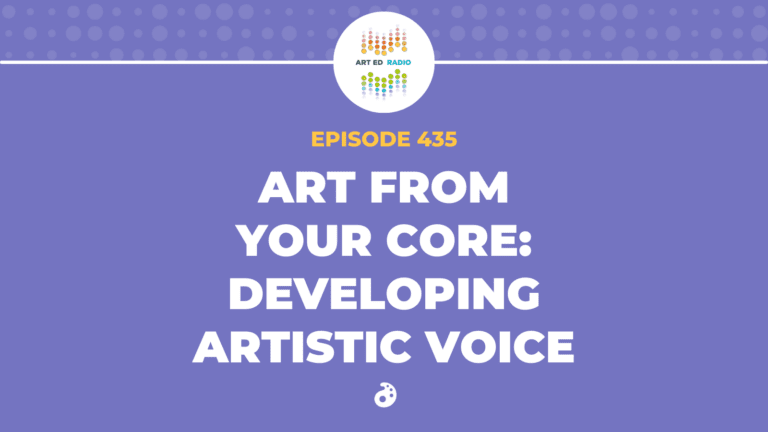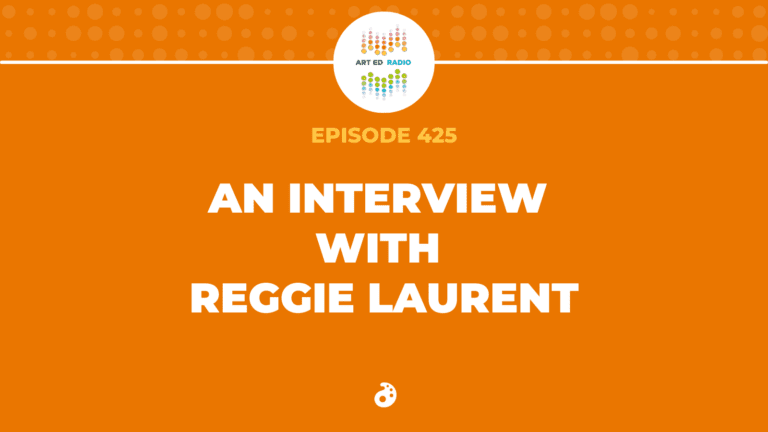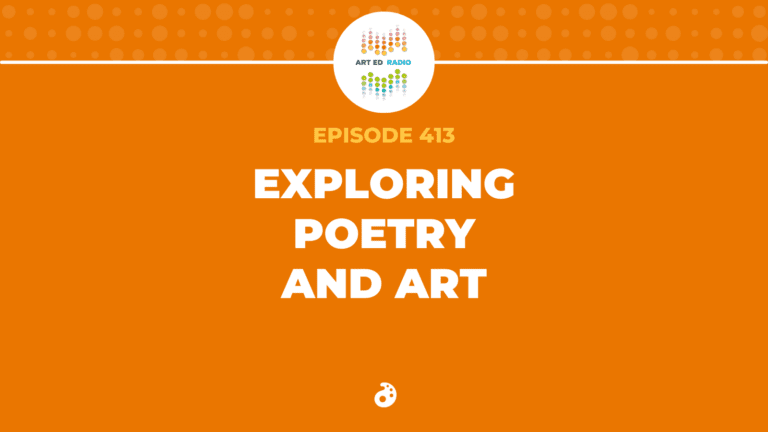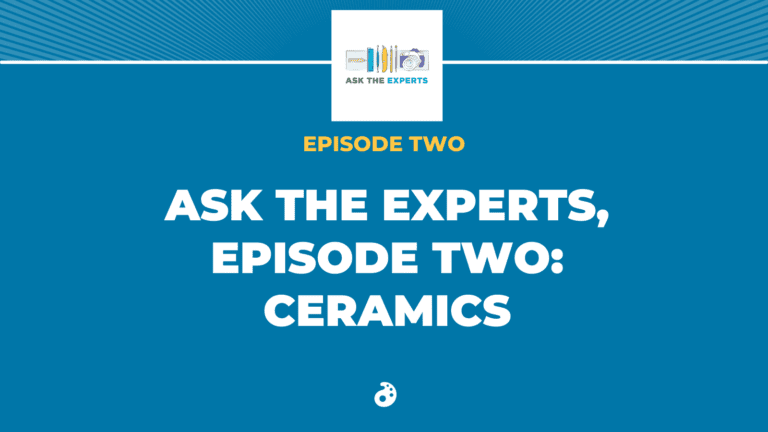We talk often about how we want our kids to be more creative with their ideas, and how we can get them to think more creatively. But how do we foster that type of development? In this episode, Tim shares some of his best strategies for creative exercises and favorite ways to develop creativity in your classroom. Full Episode Transcript Below.
Resources and Links
- Listen to Tim’s podcast with Amber
- Check out the Creativity in Crisis Graduate Course
- PRO Learning Pack: Creativity Exercises for Every Level
- PRO Learning Pack: Teaching for Creativity
- Explore all of AOEU’s Graduate Courses
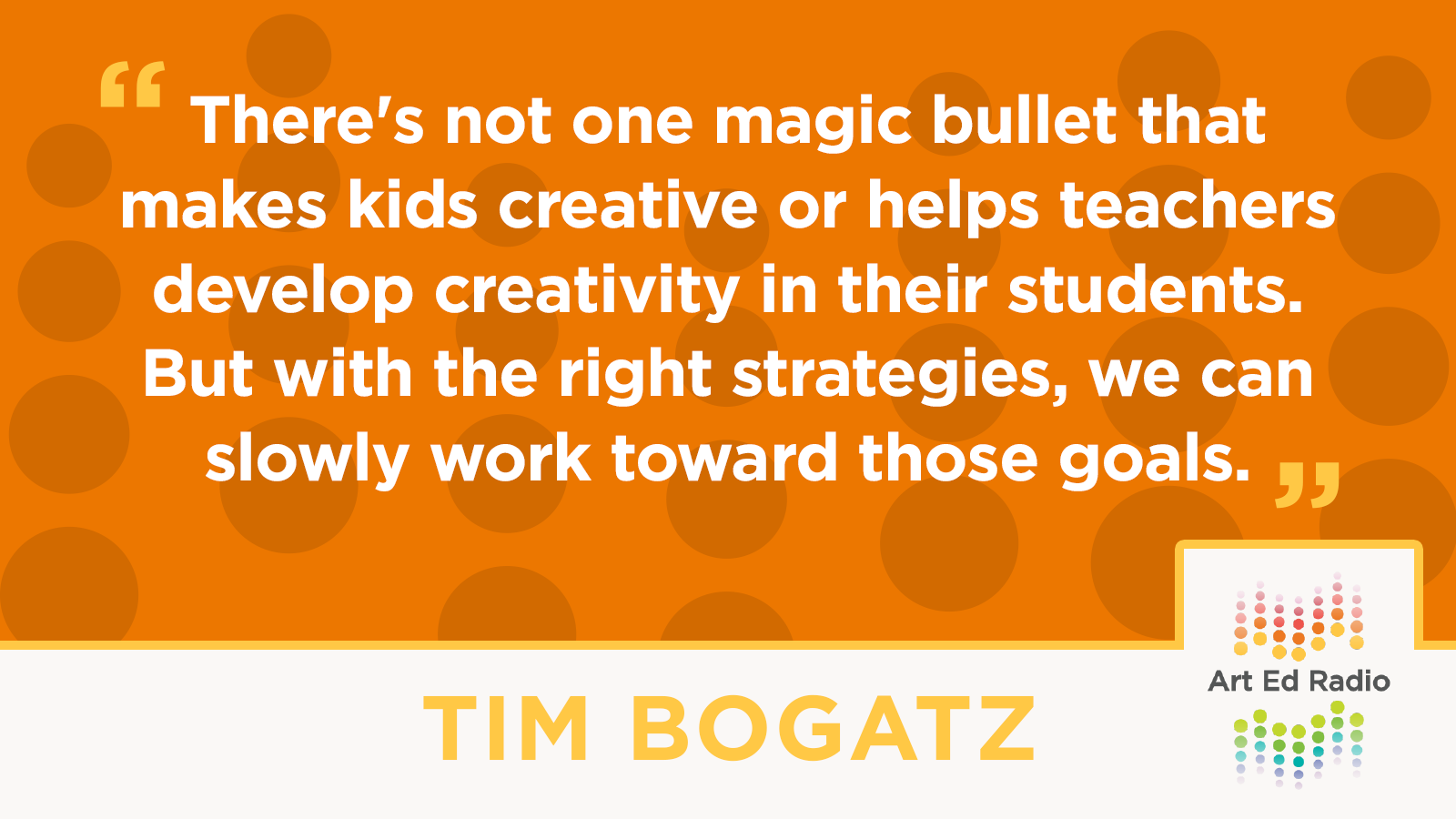
Transcript
Tim: Welcome to Art Ed Radio, the podcast for art teachers. This show is produced by the Art of Education University and I’m your host, Tim Bogatz. Now, last week we talked a little bit about calming classroom chaos and I hope some of those tips helped you out and are things that you can maybe implement in your classroom. And this week, as promised, we are going to talk a little bit about creativity. This is something that I’ve been getting a lot of questions about, how do you teach your kids to be more creative, how do you teach for creativity, et cetera, et cetera. And so because of that, I’ve been thinking a lot about creativity lately. And I guess I’ve always been interested in creativity, but that really flourished for me probably three or four years ago when I started listening and thinking a lot about what Sir Ken Robinson had to say. And also I was instructing AOEU’s Creativity in Crisis course, which is great. It’s an amazing graduate course, but it gets you past a lot of your creativity blocks and into actually more creating.
And as you’re going through there and thinking about creativity, it gets you thinking about how it relates to your classroom. How do we get our students to be more creative? And so I tried to put together this episode with kind of that in mind. And in order to do that, I went back to a podcast I did a couple of years ago with Amber Kane. Amber works with me at AOEU. She didn’t at the time back then, but in that episode we had an awesome conversation about how we get our kids to be more creative, and Amber has some amazing concrete strategies. So I was able to combine some of her ideas and put together kind of a list of strategies, a list of ideas here that will help you get your students thinking more creatively. And before we dive into that, and I guess I just want to say that there’s not one magic bullet that all of a sudden makes kids creative or helps teachers develop creativity in their students.
So instead, what I’ve thought about, what I’ve put together here with Amber’s help, as I said, are just kind of a series of small steps or a series of smaller ideas that will help your kids get on that path and help your kids start to think just a little bit more creatively. So let’s dive in. Idea number one, work as a class to define creativity. And this is something we had discussed in that podcast and it’s a great way to begin a lot of your classes and have them work together to come up with their own definition for what creativity is. It can be difficult to do that, but I think it’s worthwhile. And I think it’s good for your kids to see, your students to see that creativity is not easy to define. And even as a teacher who does this all the time, there’s not a blanket definition for what creativity is.
The kind of cool thing about that is obviously it gets kids thinking, but you can also see how that idea can evolve over time. Those definitions can change as kids get to do more and more creative things. And if you revisit that every once in a while, you can show the kids value in adapting your thinking and changing your thinking when you encounter, when you run into new information. And so I think it’s worthwhile, again, to have them kind of develop those ideas, see that it’s maybe not the cleanest thing in the world and then show them as you go through the semester, as you go through the year that things can change and your thinking and change when you encounter new information or new experiences. Idea number two, play word association games. I love just asking kids, what words did you think of when you hear the word creativity? And just asking them, that always leads to a great discussion and honestly a lot of creativity is just coming up with connections between disparate ideas or objects or concepts.
The more you practice that, the more natural it comes to you. And I think a great activity, a great way to do this with kids is just to have them come up with a few lists. And so what I do is I have all the kids grab a piece of paper and just put down like a half dozen columns and then come up with six ideas for each list, and the lists would be things like transportation or animals or food or weather or whatever you want to do there. And then they come up with six animals and six types of transportation and six different foods and six types of weather. And they fill out each of the columns. And then what I have them do is every kid will take a die, like I have a big pile of dice and each kid can take a die and they randomly roll. And so let’s say they roll a four, they take the fourth animal on their list and then they roll a three. They take the third transportation, type of transportation on their list.
They roll a one and the first animal on their list and they roll a five and it’s the fifth weather, type of weather on their list. Then what they have to do is combine all of those things together to create a new drawing or tell a story or however you want to approach it. But it’s a lot of fun to have kids come up with a good way to show, a penguin riding a jet pack through a hailstorm while eating a cheeseburger, or whatever the case may be. But you can come up with some really fun combinations. And just, like I said, coming up with those connections and figuring out how we can make things work between disparate ideas or disparate objects really helps with their creativity.
Now, back to little more serious ideas. Number three, have them write, define and defend their ideas. And a great way to do this is have students pick three things that are great examples of creativity, and maybe three things that are not great examples of creativity, things that are not creative at all. And then have them write a couple sentences about why they have that opinion. And it really forces them to kind of drill down and think about, why is this creative, why is this original? Or on the flip side, why is this not? And it’s a very simple exercise but again it gets them thinking and it’s a really good bell-ringer. It’s a really good anticipatory set that you can do without too much trouble. And it’s a good good conversation starter, I think, as well. Number four, this one’s a little more difficult, but help students appreciate the creative process.
Now obviously this is easier said than done, but we need to get students away from the mindset where they are just working for grades. And like I said, I know that’s difficult, but … And for some teachers too, and it can be difficult to just kind of sit back and look more at the process. It might require a shift in mindset or a shift in planning or a little bit of a change in how you run things. It might mean having kids do more when it comes to brainstorming or idea generation or working in sketchbooks, but I think if you get them doing that on a regular basis, especially your older students, then they can learn to see or they can begin to see how the creative process really helps their art, or how it really improves their art. So just focusing a little more on the creative process can be huge.
And just one other idea that kind of goes along with that. I’ve talked before about having multiple projects going at once where you have maybe one in-depth project that’s a little more teacher directed. Then you also have a choice project where kids are doing a little bit more of what they want, something that interests them, something that’s passionate about them, passionate … Something they are passionate about. Let me say that correctly. And then finally, they’re working on sketchbook assignments as well. And so they have those three things going at once. And I think that can be beneficial because it allows kids to try different approaches and different ideas without focusing too much on one single end product. It lets them experiment and it lets them be a little bit more creative and kind of frees them up a little bit. So there’s not that pressure of grades, there’s not that pressure of the end product and they can allow themselves to be a little bit more creative.
All right, number five, this is a great one from Amber called I wonder what would happen if. And she makes the point that even when kids are comfortable with media or comfortable with techniques, they still need to wonder. They still need to be curious. They still need to experiment. And so this approach is great, but Amber loves having kids write down three questions that start with the phrase, I wonder what would happen if. And every kid writes down three of those and then she will collect the questions and the next day all of those questions are posted on the board. Okay? From there, from those, depending on the size of your class, those dozens, if not hundreds of questions, kids will pick one and they will make art related to that question. And some of those are great, some of them are totally off the wall, but kids can pick one that appeals to them.
It could come from anywhere. But that kind of divergent thinking, focusing on curiosity, focusing on experimentation, that keeps students thinking creatively as they work. It’s a great approach. And again, a really simple one that you can implement easily. Number six. I think we need to create more interesting exit tickets. Now, I wonder what would happen if, like we just talked about, is a great exit ticket, but you can go beyond that, and you can ask kids to think about some of those connections. Think about what’s happening in the lesson versus what’s happening in their life outside of school or do an exit ticket where kids write some kind of an analogy. And the analogy doesn’t even need to make a lot of sense. Like it can be incongruent, like there’s one I love where if the Renaissance artists were pizzas, what kind of pizza would each one be?
That doesn’t make any sense whatsoever, but it’s really, really entertaining. And so kids can just kind of use their knowledge of artists or knowledge of art history to kind of come up with some ideas, and just asking them to make those connections and asking them to come up with some different types of thinking, that will always simulate their creativity. So just spend some time thinking about fun ways to do those exit tickets, or fun ways to come up with sketchbook assignments, different things that kids can do that get them thinking in new ways. So again, just spend some time having some fun with things and asking kids to make connections. They may be straightforward, they may be way out of left field, but that type of thinking, those connections is really, really beneficial to their creative thinking.
Now number seven, I think this is important. I think teachers don’t do this enough, but you need to ask new and different questions in your critiques. And not every critique needs to be about description, analyzation, interpretation, and judgment. Like, yes, we do that. Yes, it’s worthwhile, but there’s not a lot of creative thinking that goes into it. There are certain things you can do with judgment that make it a little bit more fun. I love to ask kids, say we’re studying van Gogh and his Portrait of Dr. Gachet, we’ll bring that up and say, “Hey, this painting just sold. It’s a while ago, but it’s sold for like $130 million.” Is it worth it? And they get into ideas as to whether or not that’s worth it. And then I ask them about whatever athlete who has just signed a contract for $250 or $300 million, it’s like is 10 years of that athlete worth twice as much as this painting? And get them to kind of think of the relative value of things.
That is some really good higher-order thinking and some really good judgment that can kind of play into that idea. But what I’m saying here with critiques overall though is that there are a lot of different ways that go beyond that description, analyzation, interpretation, and judgment. You can have so much more fun where you’re just giving kids awards for best use of line, best use of pattern and best use of color, things like that. You can do Olympic judging, you can have kids just write down what they love, what they learn, what suggestions they have. You can put everything up on the wall and ask them to draw connections between two different pieces and kind of explain their thinking behind it. There are a million different things that you can do with your critiques and so just be willing to open it up and your kids to do something a little differently.
We have a couple of great articles on the AOEU site that are all about critiques, how to run them in a little bit more fun or a little bit more creative ways. I will make sure I link that in the show notes and if that’s something that appeals to you, you can definitely dive in and see some of those other strategies. And then finally idea number eight is to turn procrastination into conversation. And so procrastination into conversation. Now, it can be kind of a point of contention, I guess, the difference between procrastinating and avoiding work. A lot of people think they’re one and the same. A lot of people think they are very different ideas. And I think we can all relate to the fact that ideas don’t always strike right away. But what I always tell my students is that doesn’t mean that you shouldn’t be working. Okay?
Kids can be thinking about the project, they can be writing down ideas and they can be conversing about what they could be doing. And I think it’s kind of our job to help them see how that works. If they are thinking about the project, maybe you can rephrase the problem idea for them, as you want them to write down ideas, talk to them about brainstorming or making lists or making those connections or you can be conversing with them. Going back to that conversation about what they could be doing, ask them where they’re stuck. Do they need this differentiated for them? Hey, can you adjust the project to kind of play to their strengths or play to their needs? All of those are very beneficial because it may not be just kids avoiding work. It may be them stalling until the right idea comes. But you can help them work toward that idea, help them see what they could be doing instead of just sitting.
A lot of times just that simple work of making lists or talking about the project can really jumpstart the creative process. And that’s all we can ask for, right? Like a quick jumpstart to the creative process and one that gets kids thinking and doing and creating on a higher level. And I hope that all of these ideas can you kind of get things started for you and maybe get that process going a little more often for your students. And now I mentioned the thing about critiques, I mentioned the Creativity in Crisis course but just one or I guess two more things before we go. I want to direct you to a couple of really cool things that you can access if you are an Art Ed PRO member. There are two great learning packs that are all about creativity. One is called teaching for creativity, and the other is called creativity exercises for every level. Both of them, just like every pro learning packet, have great videos, great ideas, a ton of resources that are ready to go in your classroom right now.
So if you are a PRO member, make sure you check those out. Okay? If you are not a PRO member, hey, it’s time to do that. Go talk to your admin about purchasing a membership for you. You can check it out at theartofeducation.edu/pro. All right, so there it is, a series of small steps or maybe a series of smaller ideas that will help your kids start thinking a little bit more creatively. So I hope they help you. And more than that, I hope they help the students in your classroom. Art Ed Radio is produced by the Art of Education University with audio engineering from Michael Crocker. Thank you as always for listening and we will talk to you again next week.
Magazine articles and podcasts are opinions of professional education contributors and do not necessarily represent the position of the Art of Education University (AOEU) or its academic offerings. Contributors use terms in the way they are most often talked about in the scope of their educational experiences.
